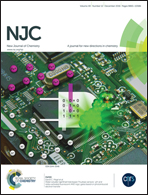Steric control on the coordination behaviour of carbazole thiosemicarbazones towards [RuH(Cl)(CO)(AsPh3)3]: a combined experimental and theoretical study†
Abstract
Treatment of substituted carbazole thiosemicarbazone derivatives, with an equimolar amount of [RuH(CO)(Cl)(AsPh3)3] in refluxing methanol in the presence of a base (NEt3), has afforded ruthenium complexes in two different types, viz. [RuH(CO)(AsPh3)2(L1)] (1) and [Ru(CO)(AsPh3)2(L2)] (2). The new complexes were separated and characterised by elemental analysis, spectral techniques (FT-IR, UV-vis, NMR and ESI-MS) and X-ray crystallography. The absorption and emission properties of the complexes were studied by both experimental and theoretical methods. The formation of the complexes was further supported by mass spectral analysis. In complex 1, the thiosemicarbazone ligand is coordinated to ruthenium in a monoanionic bidentate fashion by forming an unexpected NS four-membered chelate ring with a bite angle of 64.58(9)°. The coordinated thiosemicarbazone ligands, carbonyl and a hydride constitute one equatorial plane with the metal at the center. However, in 2 the ligand behaves in a tridentate dianionic fashion by forming CNS five- and six-membered rings via C–H activation. The tricoordinated thiosemicarbazone ligand is sharing the same equatorial plane with ruthenium and the carbonyl, and the AsPh3 ligands are mutually trans. The difference in the coordination mode of thiosemicarbazone ligands is a result of the difference in the steric nature of the substituent present in the thiosemicarbazone moiety. Density functional theory (DFT) calculations have been used to examine the composition of the frontier molecular orbitals. Further, electrostatic potential surface analysis confirms the steric nature of the phenyl group in complex 2 which dictates the diverse coordination mode of the ligand. The density of states (DOS) and overlap population density of states (OPDOS) in terms of Mulliken population analysis were calculated using the GaussSum program. The nature of the electronic transitions associated with the complexes has been determined by time-dependent DFT and the UV-vis spectra of the complexes have been discussed on this basis. The bonding interactions between the ligands and ruthenium complex fragments have been analyzed by energy decomposition analysis.
![Graphical abstract: Steric control on the coordination behaviour of carbazole thiosemicarbazones towards [RuH(Cl)(CO)(AsPh3)3]: a combined experimental and theoretical study](/en/Image/Get?imageInfo.ImageType=GA&imageInfo.ImageIdentifier.ManuscriptID=C6NJ02430K&imageInfo.ImageIdentifier.Year=2016)

 Please wait while we load your content...
Please wait while we load your content...